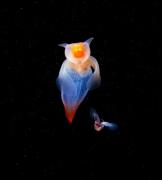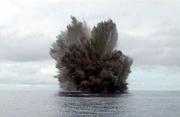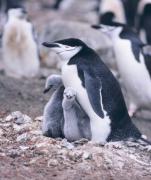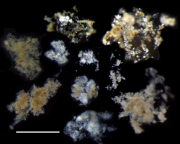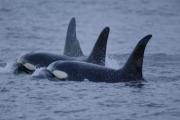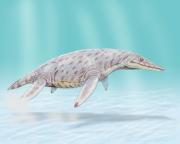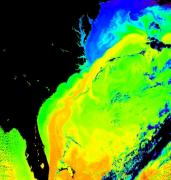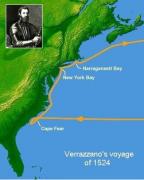Radio Program
Our regular Science and the SeaTM radio program presents marine science topics in an engaging two-minute story format. Our script writers gather ideas for the radio program from the University of Texas Marine Science Institute's researchers and from our very popular college class, Introduction to Oceanography, which we teach to hundreds of non-science majors at The University of Texas at Austin every year. Our radio programs are distributed at to commercial and public radio stations across the country.
Some tiny sea snails may look like angels, but they act more like little devils. They rip their favorite prey from their shells. And the prey just happens to be a relative.
Sea angels are found around the world, from the arctic to the tropical waters near the equator. Most range from the surface to depths of a couple of thousand feet, although some have been seen more than a mile down.
Now playing in the southwestern Pacific Ocean: Sharkcano—an underwater volcano filled with sharks.
Officially, the volcano is Kavachi. It’s named for a fire god of a nearby culture. Its base is about three-quarters of a mile deep.
Kavachi is one of the most active volcanoes on the planet—there’s almost always a little something going on. Its first recorded eruption came in 1939. Since then, it’s erupted at least eight more times, including a long-lasting one from late 2022 into ’23.
Chinstrap penguins may be contenders for the title of “world’s greatest power nappers.” A recent study found that penguins that are watching over their eggs or chicks nod off more than 10,000 times a day—for an average of just four seconds per nap.
Chinstrap penguins live in Antarctica and nearby islands. Adults stand about two and a half feet tall, and weigh up to 10 or 12 pounds. They get their name from a thin line of black feathers that look like a chinstrap. They return to their nesting grounds every October or November—hundreds of thousands or more in a single colony.
It snows in the oceans. Bacteria, the skin cells of fish, fish poop, and bits of sand and dirt all clump together. These “snowflakes” can be up to an inch or two across. Many of them are eaten as they sink toward the ocean floor. But others float all the way to the bottom—a trip that can take weeks.
The snow falls all the way down even in the deepest waters, where the pressure can be a thousand times the surface pressure or greater. In fact, a recent study suggests the pressure might actually help the snowflakes survive in the deep ocean.
Killer whales near the Atlantic coast of Spain and Portugal have been living up to their name. From May 2020 through the end of 2023, they “killed” four boats and attacked hundreds of others. Marine biologists are still trying to explain why.
They’re not the first reported whale attacks in that part of the world. In fact, the earliest known attacks anywhere took place in the northeastern Mediterranean, near Constantinople. Those attacks were blamed on a single whale: Porphyrios.
According to an old saying, a rising tide floats all boats. And in the decades ahead, rising waters will threaten all coastal cities.
As our planet gets warmer as the result of human activities, sea level is rising. So cities along the coast will see more flooding—more often, with higher water levels. But a recent study says the risk isn’t the same for everyone.
In 1983, roadworkers cut a notch in a hillside in Lorraine, a region in northeastern France. Paleontology students examined the exposed layers of rock. They found fossils of an ancient sea creature.
Scientists just recently studied the fossils in detail. They found that the fossils were the remains of a type of giant marine reptile that hadn’t been seen before. It was about 16 feet long, with jaws four feet long. It plied the Tethys Sea, which covered parts of present-day Europe. Because it was discovered in Lorraine, scientists named it Lorrainosaurus.
The Gulf Stream plays a big role in the weather and climate on both sides of the Atlantic Ocean. A recent study concluded that the Gulf Stream is slowing down. That could have an impact on everything from hurricanes to heatwaves.
The Gulf Stream is a strong current of warm water. It starts in the Gulf of Mexico, then flows up the East Coast of the United States. It then veers eastward into the North Atlantic, and finally around western Europe, where it warms part of the continent. The Gulf Stream is one of a network of currents that encircles the Atlantic Ocean.
Many people like to have some “white noise” in the background while they work or sleep. And some fish seem to like it as well. A recent study found that young Atlantic cod were attracted to a background “hum” like that produced by offshore wind turbines.
Researchers in Norway studied the impact of a low-frequency hum on 89 larval cod. They put the fish in mesh containers, then placed them in a fjord in Norway. They played the humming sound to half of the fish, but not the other half. And they recorded how the fish responded on video.
One of the great quests of the 16th century was to find a northwest passage—a shortcut from Europe to Asia. Such a route would go through or above the lands of the New World. No one ever found it because there isn’t one. But the search gave European mapmakers and scientists a lot of information about the North American coastline.

